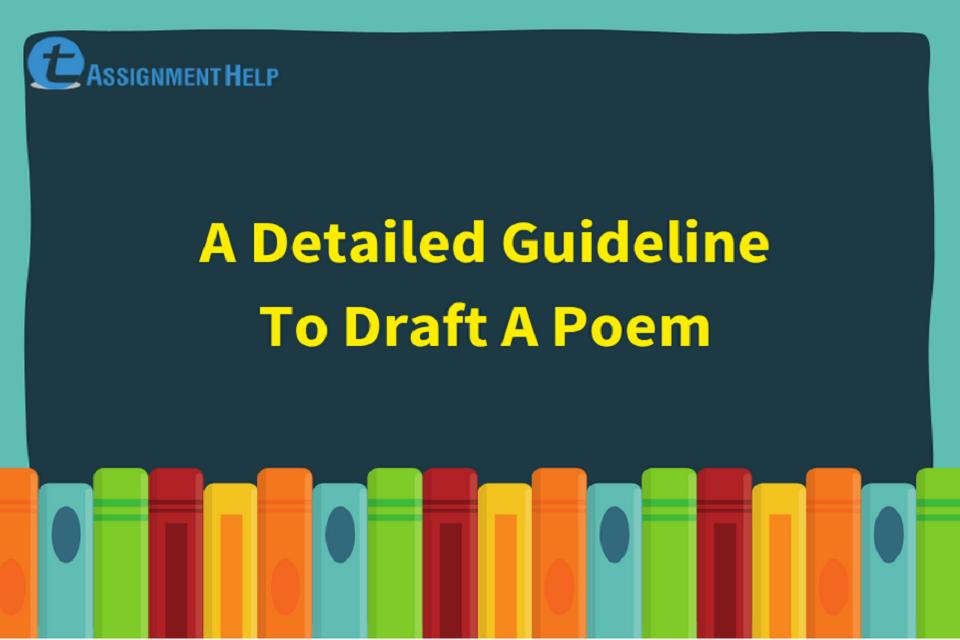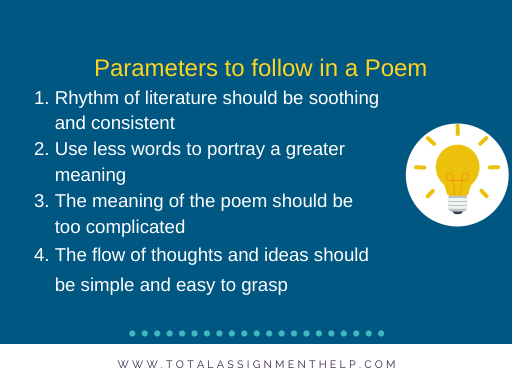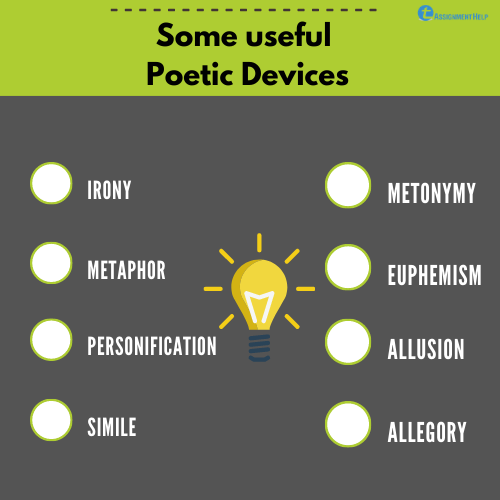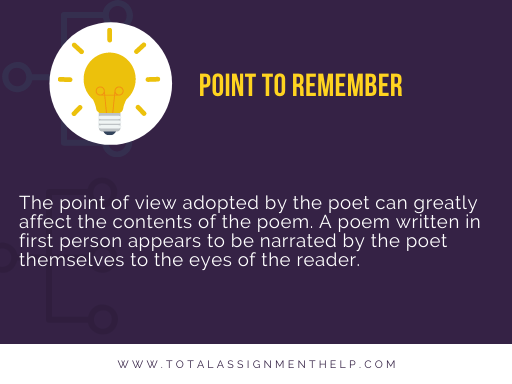Poetic Devices: A Detailed Guideline To Draft A Poem

If a person commits himself in writing poems and related literary works, he would obviously encounter with the scarcity in content and subject. The poets should have a very impressive vocabulary to express their ideas in a rhythmic way. It is based on the use of vocabulary to express the ideas that the quality of a literature is determined. The content of a standard poem should maintain the below-mentioned parameters.
- The rhythm of the literature should be soothing to the listener and thus the inconsiderate use of the word should be avoided.
- Apart from the literal meaning, the vocabulary used in the literature should represent a hidden meaning. Such characteristics would generate an element of surprise among the readers. The poet should have the ability to portray a large scope of ideas with the minimal and appropriate use of words.
- The content should have a contextual flow and thus provide the readers with a very arranged flow of information. The meaning of the poem should not be very hard to understand. If the literature is hard to read and understand, then the whole effort of writing the poem would go in vain. The primary aim of the poet is to entertain his readers or audience.
- While drafting the poem, the poet should make an effort to explore the psychological aspects of the human’s thought process, their empathy, and emotions. Though the content should not turn out to be pretentious while covering these aspects.
There is no lack of vocabulary in the English language since it is a well-developed language that has quite multiple terms to portray a single idea. Even intangible things like the state of mind could be expressed using the English vocabulary. By the use of poetic devices, the words could be arranged in various methods that could create a poetic impression among the audience. The poems should be good enough to be recited aloud before the audience. Only if the poem is read aloud, the listener could derive out the hidden meaning and the artfulness of the words and idea the author is trying to convey.
Subscribe our YouTube channel for more related videos
Rhythm and sound of the words: The content of the poem when read aloud should resemble a soothing pattern. The poet should have the ability to generate the essence of cleverness, feeling of soothing and pleasantness etc. by the effective use of vocabulary. The poems with odd patterns are less likely to be preferred by the audience. Below are provided some tools which are used to bring pattern in the drafted piece of literature.
Alliteration: If the same consonant sounds are being used at the beginning of the words in the consecutive lines, then the style could be classified as alliteration. In simple words, the use of similar consonant sounds in the adjacent words is the major modus operandi of the alliteration tools. You obviously would have heard about the movie Fast and Furious. The term Fast and Furious is one of the best examples for alliteration.
Let us consider another phrase ‘Peter and Andrew patted the pony at Ascot.’ The consonant sounds of both T and P could be taken as the tool of alliteration in this phrase. Alliteration is a very good tool, which helps in maintaining a good pattern in the poem. The use of alliteration should be used in the literature with a little bit of limitation. However, the limitation disappears in the humorous, cinquain, and limerick kind of literature.
Assonance: Apart from the tool of alliteration, where the consonants sounds were repeated, the vowel sound is repeated in the assonance tool. The vowel sounds are repeated in the adjacent places which are in stressed or accented form. Let us take an example where a very short vowel sound of A is used as assonance. Andrew patted Ascot.
Consonance: If the consonant sounds are being repeated at the end of the words in the adjacent sections or phrases, then the style could be termed as consonance. This tool should not be confused with alliteration. In alliteration, the repetition of the consonant is done in the initial part of the word apart from the consonance tool where the repetition of the consonant is done in the end part of the word. In consonance tool, better rhythm and pattern could be observed rather than in the case of alliteration. Let us consider some examples Cool Soul, and Boats into the Past.
Cacophony
If the literature lacks any pattern and retains a lot of noises and disordered display of harsh words, then the piece of literature could be classified as cacophony. The anomaly in the context along with the use of very pretentious and fancy words could be classified as cacophony. Let us take a proper example of it.
Light-footed, my steel feelers flicker
And luck from these keys melodies.
Euphony: This is the exact opposite as in the case of Cacophony. The efficient portrayal of the words would generate the soothing feeling among the readers which is termed as euphony. The euphony entirely depends on the beauty of language which is used by the author in his literature.
Onomatopoeia: The use of the words which are inspired by its sound or appearance is termed to be the onomatopoeia style. The use of onomatopoeia if combined with the style of alliteration or assonance, would provide amazing results. The sounds like tick come under the category of onomatopoeia since it signifies the exact sound as it spells. The use of onomatopoeia would bring rhythm and tone to the literature since the tool majorly focuses on the oratory aspect of the word.
The words like swoosh, buzz, snap, hiss, boom, pop, etc. would come under the category of onomatopoeia poetic device.
Repetition: In this poetic device, the author makes the intentional reiteration of the words to derive an effective tone in the literature. If a certain keyword is used in multiple phrases adjacently, the poetic device could also be termed as parallelism. The poetic device of parallelism is well popular among the world literature and its wide use could be observed in a lot of literary works. In many sacred songs from the ancient era, the poetic device of parallelism and repetition could be heavily observed.
Rhyme: Although it seems to be a trivial tool, the poetic device of rhyme is one of the most significant tools for the poet. If the words used in the poem lacks rhyming, there is a high probability that the popular mass would reject it. The vocabularies which may start differently but end in a similar note could bring good rhythm to the poem. The vowel sounds are the major factors that have the potential to bring rhythm in the poem. The words like a mime, time, slime, etc. end up in similar note and could be classified under the poetic device category of rhyme.
If the same note comes at the end of the word and the initial part of the words is different, then the poetic device could be termed as half-rhyme or slant rhyme. However, like in the word soul, foul, owl, etc. the middle notes are similar which would come under the division of consonance. The variation of near rhyme should also be considered when applying the poetic device of rhyme into the poem. The instance in which the final note of the consonant is different though the final vowel note is similar could be termed as near rhyme. The words fine and rhyme would come under the category of near rhyme.
Though being less significant, the poetic device of sight rhymes should also be considered in this instance. The words whose spelling is much similar, however, their pronunciation is much different could be considered under this category. The ideal example of these poetic devices is through, enough, bough, etc.
Rhythm: Though the conscious mind of the human mind is not aware of this poetic device, the lack of it would give a sensation of plunge in the quality of literature. The calculated and systematic implication of the syllables should be done by the author to imply this poetic device. A single extra syllable could break the rhythm of the poem. If the pattern of syllables is attained throughout the literature the poetic devices of rhythm could be easily implied. In the literary field, such a pattern of syllables is also termed as the meter. It could also be termed roughly that the arrangement of various stress points voice patterns in the literature would help in maintaining a rhythm throughout the length. The intentional distribution of the syllables throughout the poem could also be termed as scansion.
Connotation and sense of words
The meaning of the word used in the poem also contributes to the rhythm and lucrative reading of the content. The use of suitable and relevant words along with sustaining the rhythm and pattern is the major challenge of the poet. The major idea conveyed in the poem should be precise and should have large scopes. The reader would get many interpretations of poem if the scope is very large. The deeper the reader digs into the content of the literature, the more ideas should they get and if this motive is achieved by the poem, it could be considered as a quality piece of literature. Let us have a detailed look into different poetic devices that would help in achieving high quality in the drafted piece of literature.
Allegory: By the means of the poetic devices of allegory, the poet would try to transfer the spiritual and abstract ideologies. Ranging from a single word to a sentence, the allegory could be implied in any form. If looked at the group of words coming under the category of allegory poetic devices it could be observed that apart from the literal meaning, the words also imply some deeper meaning. They could only be understood only if the person has a unique and exploratory overview. Only if the reader has read the whole literature, then the real interpretation behind the allegory could be understood.
Allusion: By this poetic device, the author tries to refer to some character or event from the mythical, historical or religious background. Reference of the Biblical incidents or characters would come under the category of the poetic devices of the allusion.
Ambiguity: unclear or uncertainty in the meaning of the content used by the author or even there is any discrepancy in the contextual meaning, then it would be classified under the poetic devices of ambiguity. Sometimes it happens not because of any error but signifies the existence of other possible meanings. If the reader just looks for the literal meaning of the content used in the literature, then it is quite possible that he would end up in confusion and stop reading it.
Analogy: The poetic device of analogy is used in the context where unrelated things are related. A detailed comparison between the familiar factor with the unfamiliar factor is done when the poetic device of analogy is implied.
Apostrophe: While indicating the emotion of surprise or while acknowledging or addressing a character used in the context, the poetic devices of exclamation or apostrophe is used. Let us look at a better implication of apostrophe: – Hey God! Hey Lord! Are still any deeds I should pay for?
Cliché: The obsolete piece of style which once used to be very relevant though has lost its significance because of its overuse. If the reader has seen and reads the same style and phrasing in multiple pieces of literature in multiple times, then it is quite possible that he would not get impressed by it again and thus could be classified under the category of cliché. The phrase like busy as a bee would come under the category of poetic devices of cliché.
Connotation: The meaning the context or the word used is providing to the reader on the base of social, emotional, and psychological background. The awareness of this factor in the author would help him in selecting an appropriate and relevant word that would suit best to the context and create maximum impact on the readers.
Contrast: When to display the intensity of difference between two characteristics or situations, these poetic devices are used. The juxtaposed characters or matters would have been much more different from nature and behavior so that the efficient display of contrast should be done in the text.
Denotation: The term denotation signifies the literary meaning of that word. The dictionary meaning of a word or context used in the piece of literature would be sometimes much different than the message the author is trying to convey through them. The poem poems majorly focus on the connotative aspect of the literature and hence while drafting the poem, the author should take special note that though a group of the word would imply literary meaning, deriving the connotative aspect is a much harder task. The use of much fancier words sometimes sabotages the effort to imply hidden meanings through the literature.
Euphemism: If the concept is too harsh and has the possibility to portray the section as abrasive in front of the audience or the readers, then the author is sometimes forced or does intentionally apply the words which are much smoother and diluted version of the original words. In the literary field, these types of poetic devices are termed to be a euphemism. The major motive of the poet is to entertain the audience, not to hurt their belief and feelings. Let us take an example of a person being dead. Instead of saying that the person is dead, the poet could mention it by saying that the person is at rest which is the style of euphemism.
Hyperbole: The pretentious use of words that could exaggerate the original concept comes under the category of poetic devices of hyperbole. The expression like someone weighs a ton doesn’t mean that he weighs that much. It is to mention the extent to which the person is overweighed and the poetic devices of hyperbole would thus help in making an impression of the character much faster among the audience.
Irony: To display the reality of any instance or incident which is contrary to the reality but is conceived as a genuine and true one by the mass population. The use of the poetic devices of irony could be used to imply sarcasm in the context. This is one of the very effective poetic devices and could bring quality to the piece of literature if it is effectively implied.
Metaphor: By the use of poetic devices of the metaphor, the comparison between the things which are much different and unlike in characteristics is done. The metaphor is used to personify or characterize actions or incidents. To imply metaphor in the intended piece of literature, the writer should possess a very good range of vocabulary and high skills in the English language. You could observe a lot of metaphors in the word class pieces of literature which are considered to be evergreen.
Metonymy: As a metaphor, the poetic devices of metonymy are also used to display a comparison between two factors or instances. Instead of the person, place or substance, the reference is made to the closely linked factor for it. Saying that in the opinion of London or the government of Britain provides the same context and hence could be classified under the category of poetic devices of metonymy.
Oxymoron: In this form of style, the contrary words which would portray the opposite contextual meaning come under the division of the poetic devices of the oxymoron. The usage like a pointless point of view comes under the classification of these poetic devices.
Paradox: We have talked a lot about the poetic devices which display the contradiction, though the poetic devices which display the revelation of the hidden fact. The statement like The hurrier I go the more behind I get.
Personification: The poetic device of personification could be deemed similar to the poetic device of metaphor. The methodology in which the human characteristics are being allotted to the non-living things is termed to be under personification poetic devices. The abstract ideas and even animals are being endowed with the qualities of humans by using this tool.
Simile: The use of the terms like and as to compare two entirely different things could be classified under the division of poetic devices of simile. The usage like as busy as bee comes under the category of simile. The phrases like the eyes are like comet also comes under the division of poetic device of simile.
Synecdoche: By using this tool a group of things is being represented using a single word or phrase on a wholistic basis. The phrases like all hands in the deck are one of the best examples of this tool.
Arranging the whole idea
Now that we have learned some basic poetic devices which are used in the vocabulary to effectively portray different ideas in a very innovative manner. Now let us discuss how the content of the poem should be organized and arranged using the poetic devices.
There should be a pre-arranged or unique order in the drafted poem that should display the level of creativity implied by the author. The flow of ideas should not be mechanical in manner and hence some measures should be taken to avoid the manual progression of the context. The below section of this article deals with the tips and processes to be followed for the effective flow of contextual ideas in the poem.
Verse: The verse is the lines arranged in the pattern of metrics. In the category of the verse itself, there are some subcategories like blank verse, free verse, etc. The collection of verses could be termed as a stanza.
Point of View: While drafting the poem, the poet could select a certain point of view to narrate the ideas. The point of view could affect the quality of the content developed in the poem. If the poet chooses to take the first-person point of view then it is the poet himself who narrates the content.
The other two points of view are the third person limited and third-person omniscient. The former one, provides the narration of the whole content from a limited perception. This implies that the narrator is not meant to be the part of the context. He is just a narrator and thus have limited knowledge regarding it. In the third-person narrative, though the narrator is not part of the context, he would know every detailed aspect of it. He would have even the knowledge of the thought process of each character.
Line: If said figuratively, it is the lines that could be considered the building blocks in the poems and thus could be considered while implementing the major poetic devices. In the poetic behalf, the group of lines could be termed as connotation. Unlike other pieces of literature where the reader pauses at the end of each sentence, the natural pause should be looked for in the context of the poem.






